-
GREENHOUSE /STORAGE
12/22/2018 at 10:35 • 0 comments![]()
“AM BUILDING a 14x18 Greenhouse with storage functionality as well. IS BUILT with salvaged materials.”
-
THE PLD SHUFFLE
09/11/2017 at 04:23 • 0 comments -
BTB-1
09/05/2017 at 01:11 • 0 commentsBTB-1 IS a mysterious project. IT SIMULATES retriggerable, back-to-back monostable circuits. TRIGGER USES an inherent fact of comparator design, the delay ascribed as being asserted when logic becomes briefly contentious, instable. I use it as the trigger. Two stages retrigger each other during momentary instability with small capacitively coupled spikes, barely enough to cause runaway & a trigger which cannot occur with direct DC coupling between stages. NOW, IT has occurred to me that I should look for a way to assert THREE back-to-back stages. IF PODSIBLE, the third would allow for an EXECUTION period, analogous to the 'data valid' duration in digital bus clocking. After SYNC, & DELAY, there could be the EXECUTION period to assert intended results from logical & event confluence. NEXT TRIGGER would synchronize. BTB-1 is demonstrated in very low frequency clocking.
-
Battery Capacity
04/21/2017 at 04:32 • 0 commentsStored wattage can be estimated using the amp-hour rating.
I decided that knowing 12 volts X 1 amp for 180 minutes is a rating pertinent to calculating stored energy in watts.
Assume a .1 volt drop resulting from testing the battery charged at 12 volts delivering current through 12 ohms for a duration of 180 minutes. Power lost from the battery is 12 x 180/60 = 36 watts.
It is then assumable the battery will perform in like manner through a linear range of the discharge period when in use. Thus for a deep cycle battery charged to 13.5 volts the available power in watts is estimated as:
10 x (13.5 - 11.5) x 36 = 720 watts
-
LM334 Macro
12/01/2016 at 20:56 • 0 comments![]()
Status. REVISED. (I CORRECTED the glaring Celsius Fahrenheit screwup.) I created the LM334 macro for special status; inclusions and exemptions untold. Enjoy!
*path @boinerz
.subckt LM334 V+ V-
B1 V+ V- I=.000227*{T(KT,CT)}/RSET
.param KT=273
.param RSET=230
.param CT=temp
.func T(KT,CT) {(KT+CT)}
.backanno
.end
-
Inductive Load Center - Wireless Hub
07/12/2016 at 00:47 • 0 commentsOn solar power, I have now added a 4.2 cubic foot refrigerator (about 28 watts) and have used the Nuwave type halogen countertop oven twice to cook chicken 45 minutes at midday. This of course is in addition to typical demands for water, septic, lights, laptop charging, and my 35-watt, 32-inch television. Add ocassional use of a vacuum, and power tools. So far, there has not been an overload, but it is because I avoid one. The inductive load center can provide a framework for ensuring power demands do not overlap. The NuWave oven could be fitted with a wireless sensing device, asserting a PRQ to the wireless hub. The hub is then hard-wired to the Inductive Load Center.
Considering the oven, and power tools with a compressor, it is logical to look at a manual PRQ switch for high priority manual control. This leads to considering a wireless hub, necessary to implement the Inductive Load Center without extra wiring. The hub would be hard wired to the load center from a central location where wireless signals can be received.
The refrigerator has had no effect on battery levels. Midday power use is replenished even in cloudy weather. Today, a rainy day was first dark day in some time.
-
-
I Endorse "Bernie Sanders"
03/14/2016 at 19:20 • 0 commentsI endorse Bernie Sanders who seems to understand that socialism presents the only possible improvements to a set of problems caused by greed, and other Trump-like human-imperfection.
-
My Solar Array
10/05/2015 at 16:23 • 0 comments12-16-15
Bought two 180aH batteries to increase storage by 50%. The charge will help pass the next few days more comfortably. When sun returns, controller will pass more power into storage, diverting less in PWM mode. Expansion here seems a better investment than a generator, which I would use rarely. Looking ahead to the next two weeks, cloudiness and low light are eminent. Expansion will change performance, and make it easier to use a refrigerator in the spring.
12-15-15
Again there was power for lights and to pump water thirty seconds, and then fifteen. This time, I turned the inverter off to save power for morning. Snow is coming in tonight, but I plan to drive to make an appointment with my chiropractor. My back is giving me trouble and this time it is taking a few treatments. Paddy has been lame for the past few days, cannot say why. Could it be from running too hard? Loss of appetite suggests he was sick, or worse, possibly poisoned. That he was sick seems the case.
I may buy batteries tomorrow justifying this upgrade as planned sometime anyway. Fresh batteries will help make it through until January with a little more comfort. Snow and back trouble do not mix. I have some PT work, holding nearly $500 today.
12-14-15
I was relieved to find after spending the first two hours of darkness this evening, that my solar array actually charged batteries enough for three hours plus of lighting. From the completely discharged state this morning, I had power for two hours, and turned it off. There is power for lights in the morning. This makes a huge difference. If I am to spend money upgrading, it will not be for a noisy, expensive, gasoline generator and battery chargers. No, it will be to add a couple charged batteries to my system. I would get through a few days of this gloom, and have improved ability to capture free power going forward. The generator is not that nice, and I could make it without adding the batteries. It was a dark, cloudy day. What a relief!
-12-15 Another dark and cloudy day.
I added two panels this weekend (10-3-15) to distribute input, now including that from SE facing panels. Sunday was a perfect day to see the expanded window working, charging ten hours or more, most in bright sunlight.

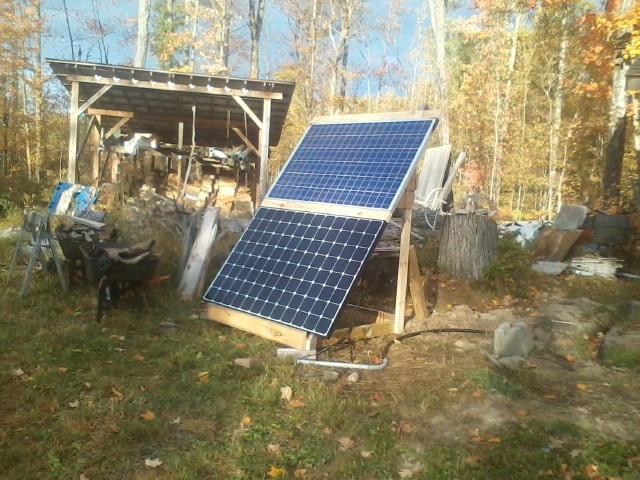
Panels now face SE and SW, reducing midday input somewhat, while adding about four hours to the window (for this time of year.) I estimate that I had nearly same input yesterday as in July. Morning charging began much sooner, and was very noticeable by 11:30 as the controller was already protecting the batteries.
Work this week will use components ( buss, fuses, connectors, cables ... ) found in boating accessories for battery management to rewire the batteries, controller, and inverter and pass electrical inspection.
I use about 90 feet AWG 6 copper to run from the combiner disconnect point to the controller. Panels are 327 watts at 54 volts, except one salvaged from the fire which is 195 watts at 27.
I'll make a diagram, and post pictures of the battery management components, with inverter connections. The boating industry uses fuses, and resettable breakers as DC disconnects. The products are not seen in solar power distribution channels, though they are competitively priced, and adequate for voltages and ampacity in my 24-volt system which uses a 5000-watt modified sine inverter.
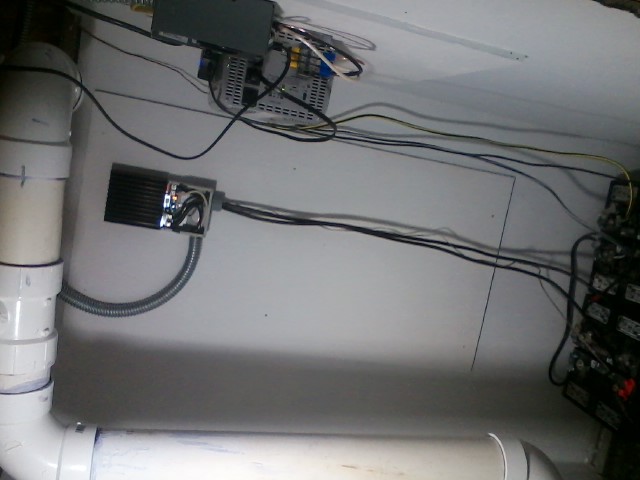
Rotated picture does not show fuses and buss components. It does show the steel raceway bringing AWG 6 from the combiner safety switch.
I have run the inverer 24/7 since June, now using a 15-amp circuit to the garage. AWG 8 brings power to the garage, a distance of 110 feet from the inverter.
-
Selfie
08/03/2015 at 13:58 • 0 commentsI added my selfie to this profile.

-
"Over-loading" a simple problem that must NOT be solved.
07/22/2015 at 17:23 • 0 commentsI have decided there must be a reason more Americans are not "off-grid' depending solely on solar input. It Is for lack of a solution to prevent too many inductive loads from switching on at the same time. Lead-acid battery technology has been here for a century with little improvement. The periodic table provides few options for development of batteries, comprised of materials abundant and available.
We do not trust government and industry to correct the on-going environmental disaster of America. Simply, we lack consumer power to articulate change demanded by a worldly consensus of common sense.
Lacking a device to prevent over-loading, America refuses to allow technology to undermine the power of an industry that made a choice nearly a century ago, and began crusading for legislation to protect its interests. The new technology is here, but is expensive, regulated, and lacking a vital component to prevent over-loading.
-
nsa
07/17/2015 at 00:10 • 0 commentsI wish I could get my life, my burned down house, and my dog back. It took 2 hours again to get my computer back from the clause of the nsa, courtesy the "essentials" of protection. I could not even send an email.
I invented the Inductive Load Center because it is the right thing to do for the world.
-
Solar System
07/12/2015 at 16:17 • 0 commentsBlock Diagram
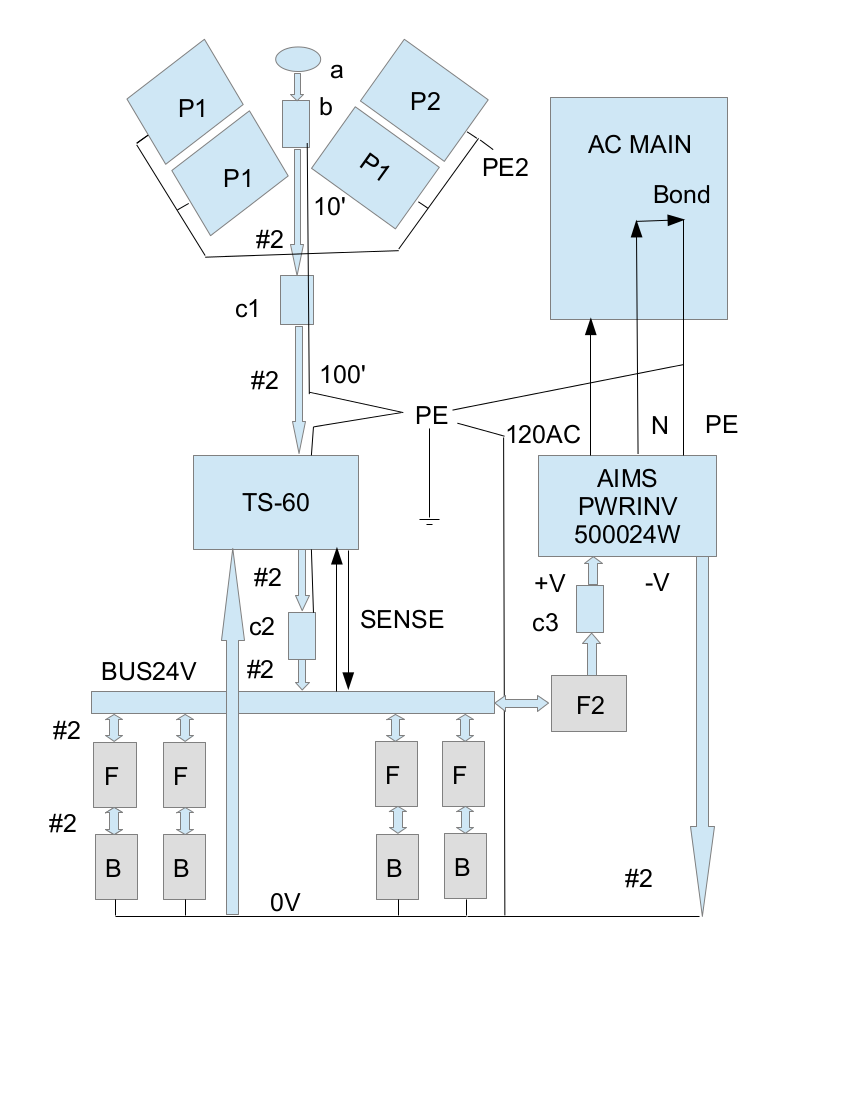
Three safety disconnects are required. A fuse in series with each 24V battery, as well as a fuse in series with the inverter disconnect switch. Home Depot offers a reasonably priced selection of switches DC rated, usable for this application. Locking is a requirement for the array disconnect, preventing tampering/disconnection. It must be rated for outdoor use. Otherwise, the controller to battery disconnect is inexpensive 30A 2-pole. However switch c3, to disconnect the batteries from the inverter, is ideally rated for 200A. Home Depot offers a suitable 2-pole 100A switch for less than $100. With ratings upward of 100A, switches become expensive. NEC inspection is likely to find these DC-rated switch components acceptable (my system voltage is 28.)
Beyond this, there is requirement for battery interconnection to be of stranded type. I plan to use two MNBABYBOX enclosures. One with the battery fuses. The other at the array with a 150V/63A GCFI breaker. The disconnect switch must be within 10-feet of the array. All switches require labeling.
I plan to use AWG#2 aluminum wherever possible, but may find it optimal to use #6 copper in some places.
All this, and I could decide to put the 28-volt conductor entering my basement into flex steel conduit. After everything, it is a reasonable cost to add this protection, same as required for conductors entering from the well.
It is difficult to decipher everything and filter what is needed for my installation, much of NEC regulation intended for larger, higher voltage installations. It should not be impossible. for me to apply common sense, and then solve compliance issues, one at a time.
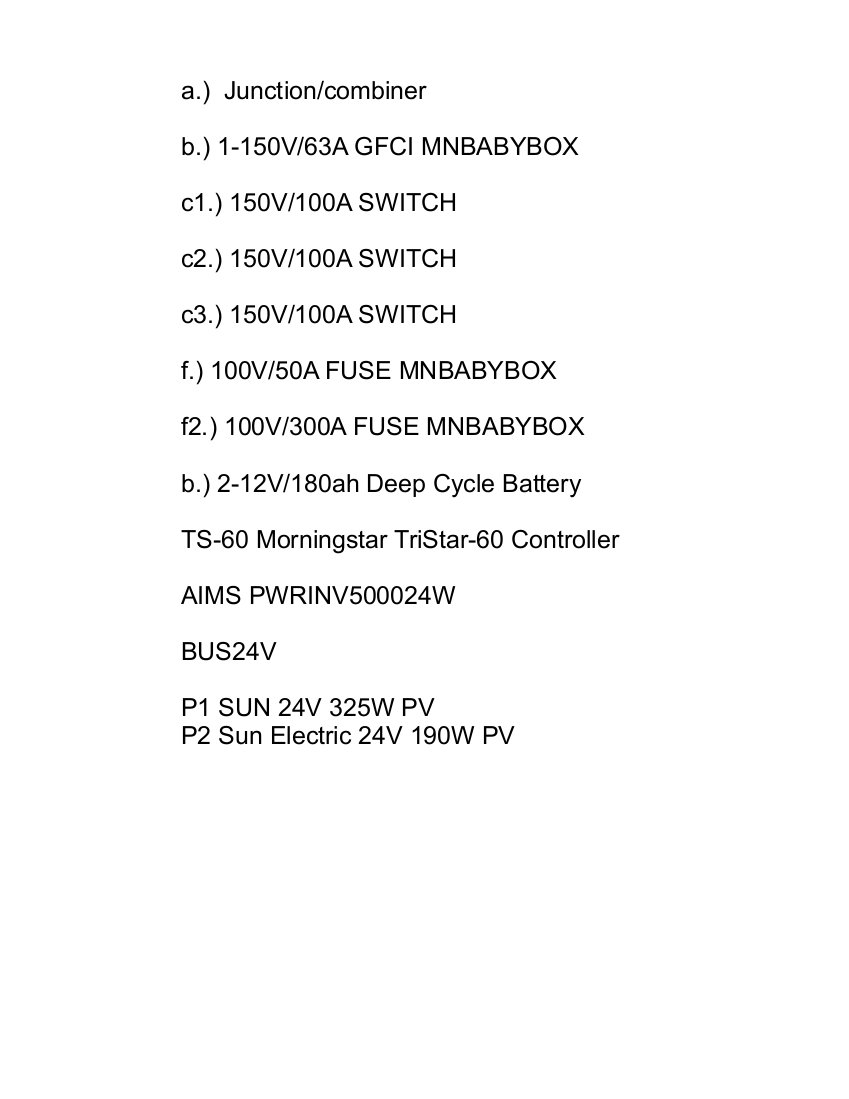
-
Exclusivity Switch Diagram
06/24/2015 at 13:20 • 0 comments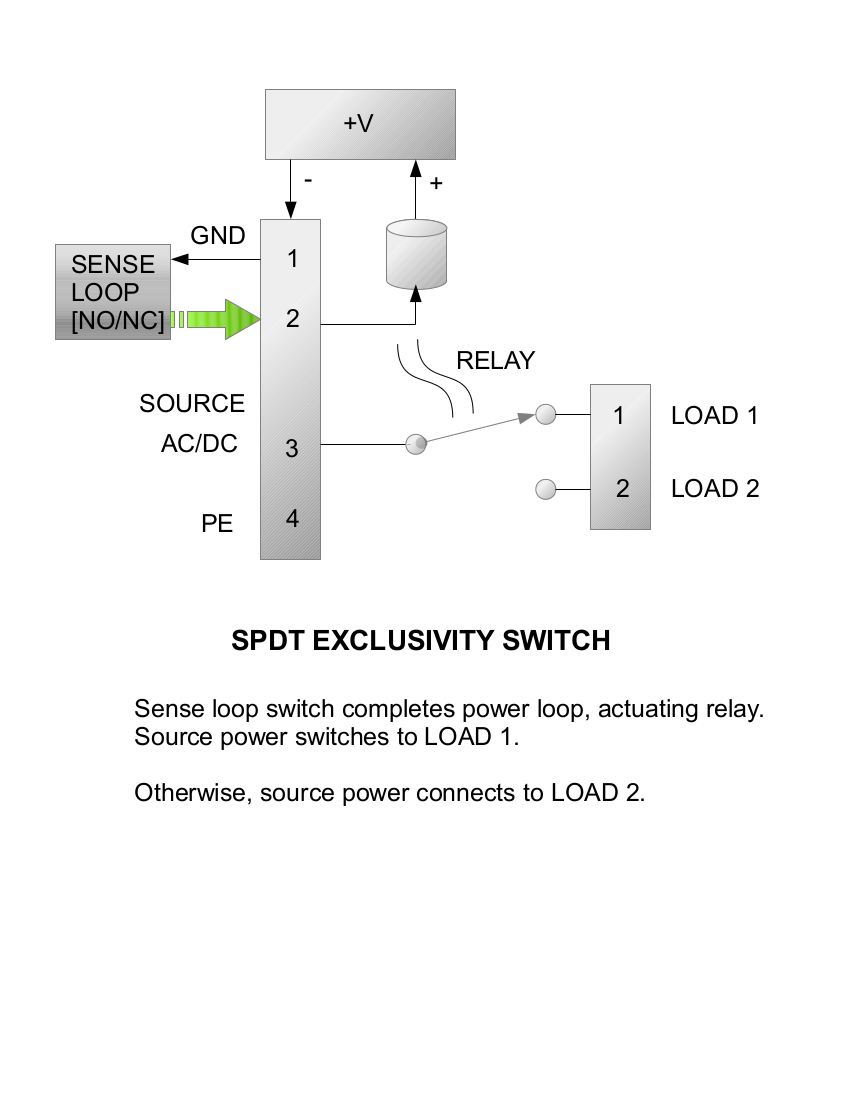
I uploaded these here after having a problem adding them to the project. Switch may be used in reverse shown below. Sense loop can vary.
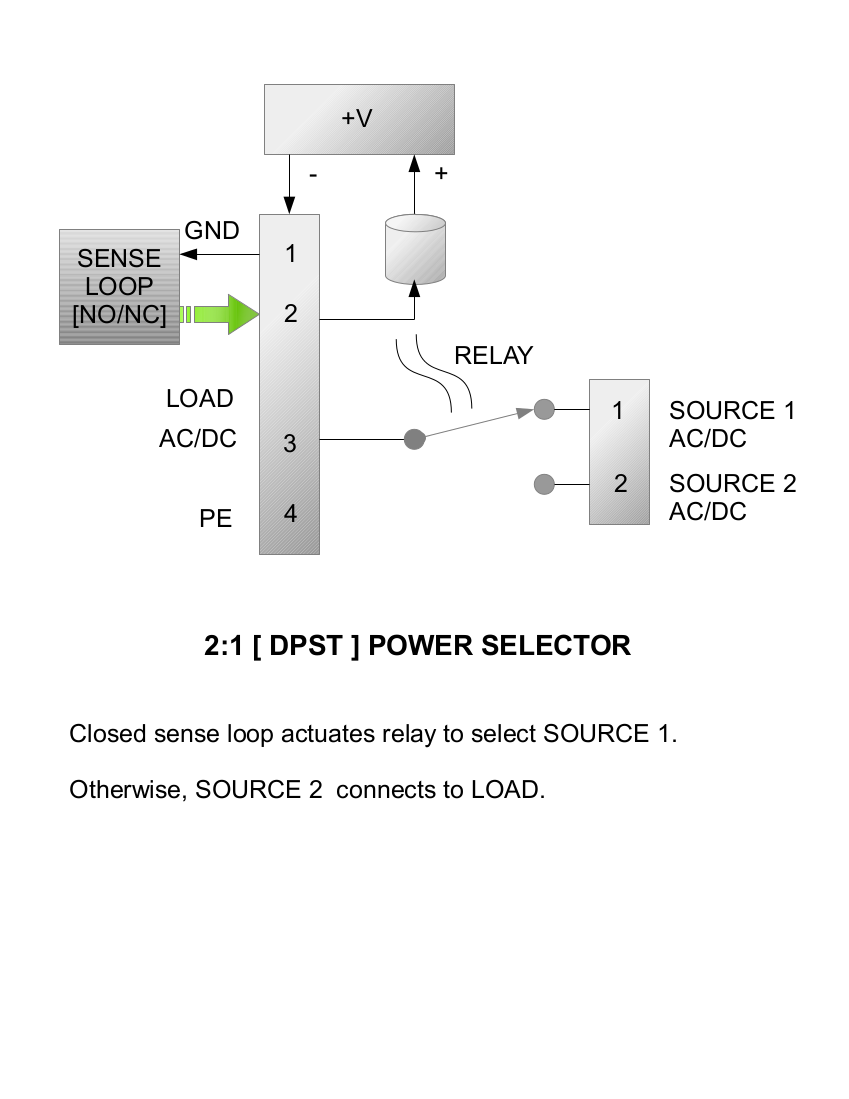
-
Solar Installation
06/22/2015 at 14:42 • 0 commentsI'll post a page outlining my solar electrical installation, now ready for state inspection.
Earth ground bonds include solar negative, disconnect switch enclosure chassis, main panel chassis, solar controller chassis with both negative potentials, battery negative, inverter chassis, as well as the inverter AC neutral output (bonded to Earth potential by the standard green bonding screw.)
Inspectors here rarely encounter an off-grid solar inspection, needed for insurance purposes.
A few pictures disclosing the bonding techniques may be informative.
The only thing I may need to do is enclose the 24-volt solar power conductors in conduit. There is conduit for these lines from the controller to the basement, as well as for the inverter AC lines. The Morningstar 60A controller is mounted next to the main panel immediately behind my entry door. It is a nice-looking, neat installation. Solar connections use pre-made MC4 to the exterior disconnect switch. It is temporarily a 650-watt, 2-panel array with for 180 ah, 12-volt batteries configured for 24-volts. It performs well, charging batteries even on cloudy days. The AIMS 5000-watt inverter pumps water from my 4-inch deep well with no problem. It also runs my compressor on the 15-amp, ground fault circuit which includes outlets in my small kitchen and bathroom as well as the outdoor, weatherized outlet.
-
Do The Carpentry
06/12/2015 at 14:39 • 0 comments
Apply Trigonometry to determine point to point length of the rear brace, and its point of intersection with the main inclined panel support. Result is a support surface for solar panels at desired inclination. Screws fasten the panels to wood above and below each panel.
INPUTS: BASE, Inclination (IL)
DEFINE the side holding the panels: Y
DEFINE the rear vertical brace: X
THEN:
Y:= BASE/sin(IL)
X:= cos(IL) * Y
I used a 48-inch 4x4 base. It is sturdy.
The mount can be anchored with a bag or two of sand across the base. An adjustable mount would be nice for winter at my location.
-
New Project?
06/03/2015 at 17:37 • 0 commentsCirculate glycol around a firebox, heating the glycol like an on-demand water-heater.
Am thinking to use an existing wood-stove, suited to wrap 3/8 copper tubing around the cylindrical (barrel type) firebox. Box is made of heavy 1/2 inch thick, 24-inch diameter pipeline pipe. I could enclose the stove except frontal access, in concrete blocks, lined with metal. That structure could be enclosed in an insulated wood frame, and steel roof. I'd use a metal chimney, and build the thing on one edge of my concrete slab. A pump would circulate glycol around the stove, and through a 50 gallon tank, also enclosed in the insulated structure. From the tank, I'd circulate heated glycol from the tank via PEX through lines under my 6' 1" basement 10x18 concrete. I'd try it on a solar budget using power stored in batteries, with input from my 1170-watt array.
All I need to purchase for this project is the concrete block, insulation, some lumber, the chimney, circulation pumps, and fittings. Fact that the 10x18 concrete basement is so small may make this viable.
Glycol circulates around firebox into 50-gallon tank. Then in a separate loop, from the tank through the PEX under my 10x18 basement. 3/8ths copper tubing wraps around the firebox absorbing as much heat from the fire as possible.
Of course, controls are needed, and if the system is closed, two safety valves must be installed. These things are readily available from a local store as replacement parts for outdoor wood boilers. Problem is to find an algorithm for control. Also, it may be advantageous to approach the problem WITHOUT the storage tank, looking at the transfer from a simpler perspective. Function of control may be to detect when firebox temperature drops, and to then moderate circulation, allowing more time for absorption. An adjustable indicator may alert when this condition warrants re-supplying the firebox.
Wood boilers contain about 200 gallons glycol-water mix. They sell for about $4,000. I'm looking to try this on a low budget. It may be possible to combine with a solar collector to heat the glycol-water mix.
-
I checked yesterday, and found at one local store a pump rated at 1/30th HP. (747/30 = 24.9 WATTS) Control to moderate flow rate will save power, especially if a SOLAR COLLECTOR is used during the day. It may be possible to get by using less than 400 watts to circulate the glycol mix on a cold winter day. Algorithm to moderate flow, and provide an alert is much simpler without a storage tank. Typical use then is to maximize benefit of the fire, keeping a long-burning fire. System storage is in the basement concrete floor. Insulating the structure is key to surviving minus thirty-five in relative comfort. Perhaps the tank with safety could be used in flow series, instead of parallel, allowing safety release valves for that benefit. Also, the fluid level could be maintained with less frequent checking.
Without two pumps, the simpler system seems viable. It is an on-going project in conceptualizing, and planning stage.
-
$1/watt Solar Panels (Blems)
05/29/2015 at 16:24 • 0 commentsRX'd 975 watts solar panels today. Paid $1/watt including shipping for these. Fingerprints in corners from handling before encapsulating resin was fully dry, seems to be the blemish. These are new high efficiency SUN product. I will use a PWM controller, orienting panels 30 degrees each side of 180 (south.) Distribution will limit time controller works to protect batteries from intense midday charging. As well, the panels will not get as hot.
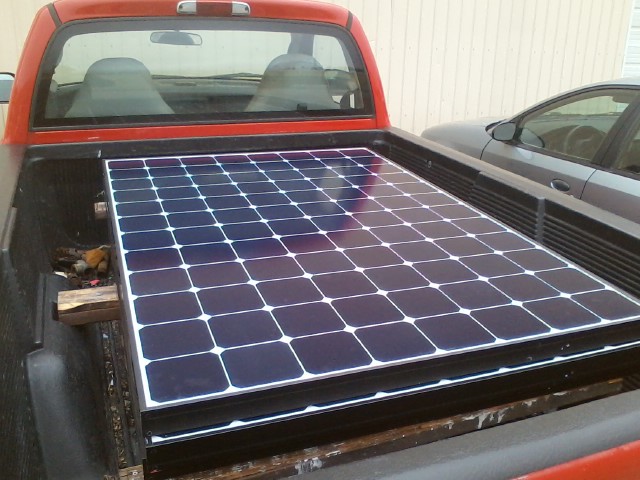
New from China? These panels are SUN product with no labels. They sure look hot to me! (A salvaged panel is on the left.) I got along okay with 700 watts. I plan on using additional power for occasional vacuuming, and to circulate glycol mixes for heating and refrigeration.
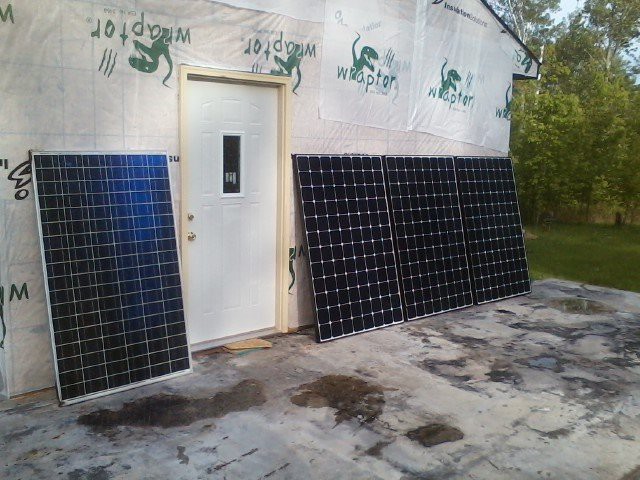
1170 WATTS
-
Oscillator Simulation (LTSPICE)
05/28/2015 at 16:10 • 0 commentsI created this oscillator from a diagram in a UTC data book.
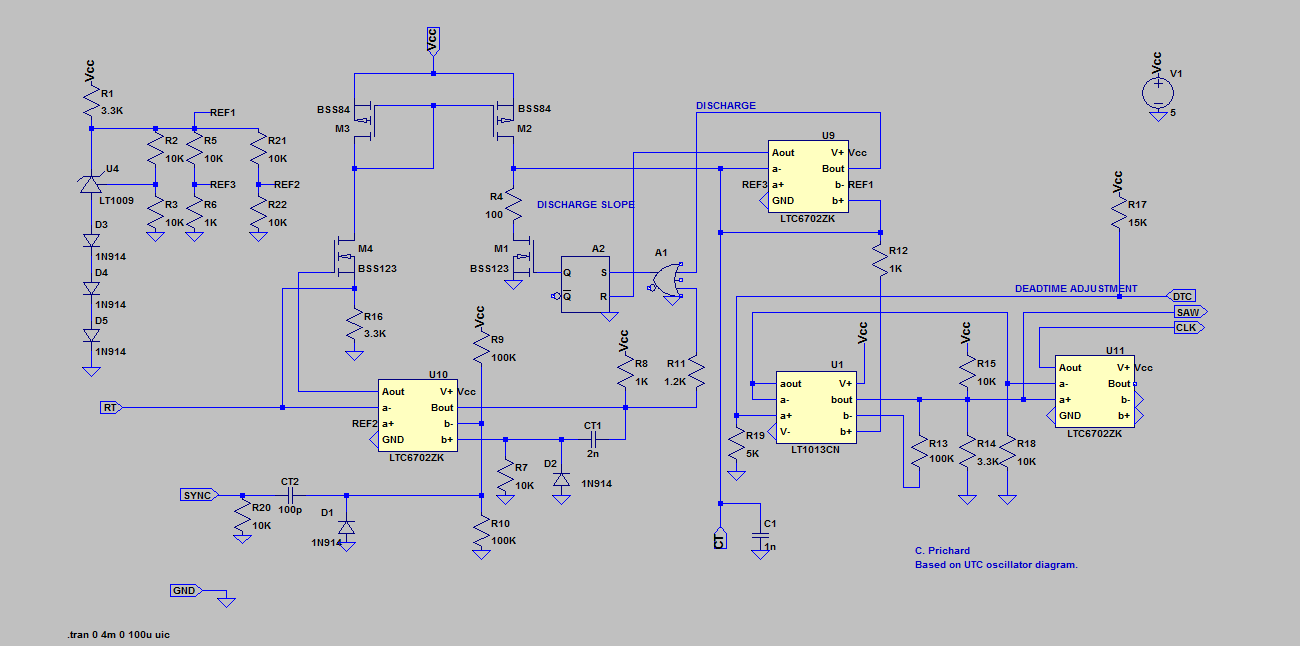
The output is nice, allowing a 90% duty cycle as well as a beautiful sawtooth. Am looking to use it in an inverter simulation.
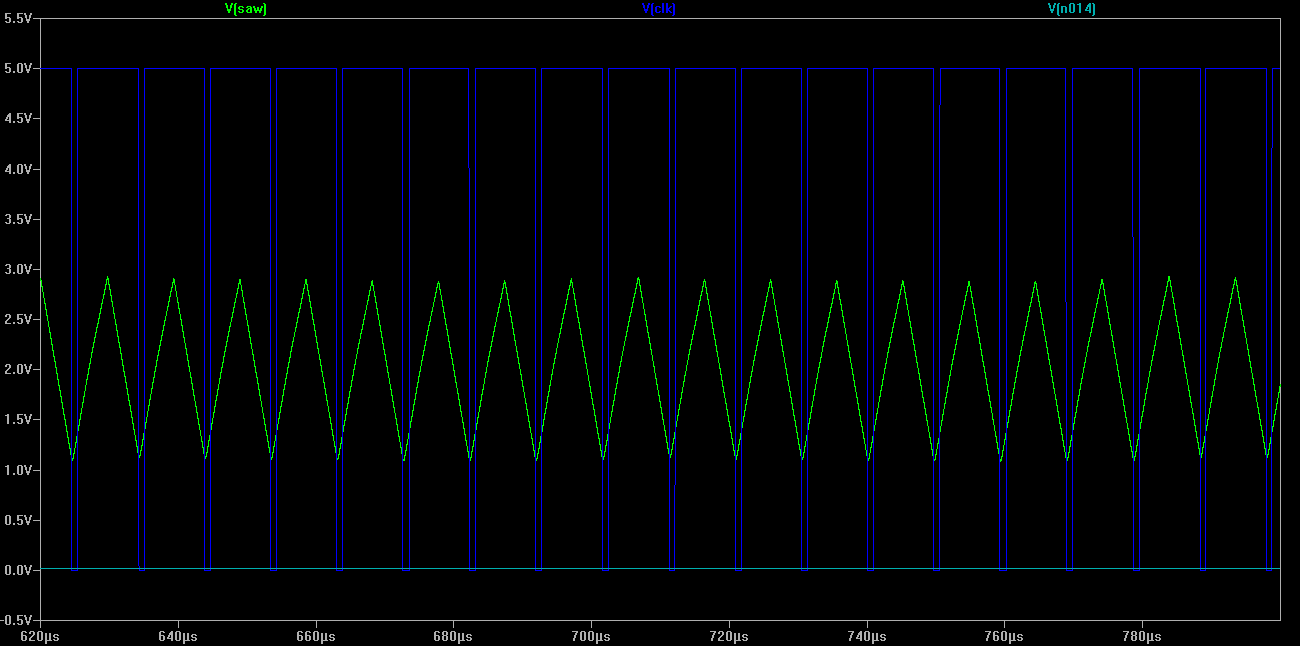
-
Links to External Stuff
05/22/2015 at 20:11 • 0 comments -
Latched Parallel Switch
05/20/2015 at 17:21 • 0 commentsI once successfully tested 4066 CMOS switch to initiate a keypress on an etched smartphone pad "substrate" with membrane removed. I was interested in having Arduino dial a cell phone interfaced with a 4066 switch matrix. I think the November Nuts-Volts issue highlighting the project which dialed a cell phone was is 2012-13, not sure. I tried the 4066, was planning to build the dialer. Now, I think I will just pay $14.95 monthly for Simpli-____, about $6 more than I would pay for a dedicated prepaid cell phone.
Before fire destroyed nearly everything I owned, I had an AIMS inverter with RF remote. It was nice. I intend to add RF to this less expensive model, but want it as cheaply as possible. ADAFRUIT sells 315 MHz pair, with toggle, momentary, or latch options. I might try a PNP and resistor across the AIMS ON/OFF panel switch. Testing the PNP is easy, pulling the base with a series resistor to GND. The RF pieces total 10$ plus shipping. Nice thing about the 4066 is the low power needed to sustain the ON condition. CMOS requires only the static voltage, great for battery-powered application. It may be reasonable to use a small rechargeable battery with the RF receiver for this use, though it would also be reasonable to derive the needed voltage from one of the solar-charged, 12V 180aH batteries. Other solutions for this may use a latched relay, which requires power, and is expensive, (plus the shipping and handling.)
I will begin by holding a resistor across the open switch, searching for a reasonable value.

C. Prichard's pages
Nearing 62, fabulous OFF-GRID vantage. In quest of manufacture GIG to put online. Interest in Solar-E, Security, and Golf. Felon

